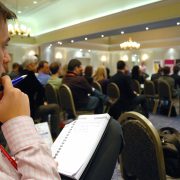So what happens after your event?
At the Financial Broker conference last week, lots of people remarked to me how good it was to be out at an event again. For some, this was the first time in a busy room again… For some others, they have been running webinars for clients during Covid, but are now back setting up face-to-face client events again. These have been delivered by interesting and expert speakers, covering valuable topics for their clients. However one area that can always be improved is in the whole area of follow-ups – what happens after the event. Here are a few thoughts on maximising the impact of your event, to really ensure that it was worth all of the effort put into it.
Prepare in advance for afterwards
You know who your speakers are and you know the topics that they will be presenting. You may also have any presentation slides in advance. So it’s relatively easy to have a few of the main follow-up assets fully or mostly prepared in advance. If these are left until after the event, they often get forgotten in the rush to get back to urgent client work. You can have the following prepared and ready to go,
- A page or blog post on your website dedicated to the event. This should have a link to a recording of the event or snippets from it, that can be accessed via a completed form – this way you get to see who is downloading it and is interested in the topic. As part of this access to the event content, encourage the user to sign up for your newsletter / other events so that you can then stay on their radar into the future.
- An email to attendees, thanking them for taking the time to attend and linking through to the event page on your website. Better still, prepare this in your newsletter software where you can track who opens and clicks on your email.
- An email to people who couldn’t make it, advising them that there’s a recording (or snippets) available via the link to the event website page. As above, do this in your newsletter software.
- If you happen to have any other relevant content on the topics covered on the webinar (whitepapers, blog articles, podcasts etc.), insert the links to these too.
When you prepare this in advance, you can be ready to go immediately after the event has finished and while it is still fresh in people’s minds.
Get active on social media
Then it’s time to get out and let the wider world know about the value you add to your clients. Publicise the success of your event on social media, leading people to the event page / blog on your website. Of course, once they are here, they may want to watch a recording of the event – to do so, they have to fill out your form, give you your email address and enable you to include them in your expert communications going forwards. Now you’re using your event to draw prospects to your business…
Review the analytics
After all of this, you’ll have pretty rich data. This will include,
- How many people attended the event
- Who they are
- Who interacted with your emails
- Who liked / commented on your social media posts
- How many / who requested the recording
- Some advisers have also sent out very brief post-event surveys, checking the pieces that people got most value from and seeking general feedback. This is more data to consider.
It’s one thing having all of this data, the important task is to use it. Block out an hour or two in your diary maybe a week after the event to go through the analytics. Was the event a success? What could be done better in the future? Most importantly, are their specific individuals who really engaged with the content and who might welcome a follow-up call?
Follow up
Where it makes sense, follow up with those individuals who were very interested in the topic. It’s quite possible that they are mulling over an issue in that space? Reach out with the offer of a remote follow-up conversation – this will enable each of you to see if there is something to explore a bit more, without investing much time in doing so. This might be where your event leads you into a wider planning conversation with a prospective client…
Next time you’re running an event, invest a little time in post-event activity. It will be worth the effort.




